The ASUS Zenfone 8 Hands-On Review: A New Compact Direction
by Andrei Frumusanu on May 12, 2021 1:30 PM EST- Posted in
- Smartphones
- Asus
- Mobile
- Zenfone 8

Today ASUS is launching their new mainstream line-up of flagship devices, the Zenfone 8 series. Unlike last year’s iteration of the Zenfone 7 which was defined by the flip-camera design, ASUS is mixing up the formula this year with the new Zenfone 8, a completely different phone in a completely different form-factor, targeting a niche in the market which ASUS sees as an opportunity to differentiate itself in.
The Zenfone 8 is defined by its size: with a 5.9” screen and a width and height of 68.5 and 148mm, it’s by far one of the smallest flagship SoC powered devices in the market. It’s an extreme departure from the Zenfone 7 – however ASUS also introduces the Zenfone 8 Flip, essentially a Snapdragon 888 upgrade over what we’ve seen in the Zenfone 7, though this variant of the Zenfone 8 will be limited in terms of market availability, and today’s article will focus on the smaller Zenfone 8.
| ASUS ZenFone 8 Series | |||||
| ZenFone 8 Flip |
ZenFone 8 |
||||
| SoC | Qualcomm Snapdragon 888 1x Cortex-X1 @ 2.84GHz 3x Cortex-A78 @ 2.42GHz 4x Cortex-A55 @ 1.80GHz Adreno 660 @ 840MHz |
||||
| DRAM | 6 GB LPDDR5 | 6/8/16 GB LPDDR5 | |||
| Storage | 128GB UFS 3.1 + microSD |
128/256GB UFS 3.1 | |||
| Display | 6.67" AMOLED 2400 x 1080 (20:9) 90Hz 200Hz Touch |
5.9" AMOLED 2400 x 1080 (20:9) 120Hz 240Hz Touch |
|||
| Size | Height | 165.08 mm | 148.0 mm | ||
| Width | 77.28 mm | 68.5 mm | |||
| Depth | 9.6 mm | 8.9 mm | |||
| Weight | 230 grams | 169 grams | |||
| Battery Capacity | 5000mAh 30W charging (PD3.0) |
4000mAh 30W charging (PD3.0) |
|||
| Wireless Charging | - | ||||
| Rear Cameras | |||||
| Main | 64MP IMX686 0.8µm pixels (1.6µm 4:1 16MP) f/1.7 |
64MP IMX686 0.8µm pixels (1.6µm 4:1 16MP) f/1.7 w/OIS |
|||
| Telephoto | 8MP 3x optical zoom f/2.4 |
n/a | |||
| Wide | 12MP IMX363 1.4µm pixels Dual PDAF 113° FoV ultra-wide f/2.2 |
||||
| Extra | - | ||||
| Front Camera | Flip-camera Design Front cameras = Rear cameras |
12MP IMX663 1.22µm |
|||
| I/O | USB-C | USB-C 3.5mm headphone |
|||
| Wireless (local) | 802.11ax WiFi-6 Bluetooth 5.1 LE + NFC |
||||
| Other Features | Triple-function Power Button w/ Capacitive Fingerprint Sensor | IP68 Dual Speakers Under-screen fingerprint sensor |
|||
| Dual-SIM | Dual nanoSIM | ||||
| Launch Price | 21,999 TWD (USD~748, EUR~626) |
starting 599€ | |||
The Zenfone 8 and 8 Flip are powered by the new Snapdragon 888. We’ve reviewed the SoC quite extensively over the last few months in a wide range of devices from various vendors – the chip is characterised by increased performance coming at a cost of quite higher power usage due to the shift to a regressed 5nm process node.
ASUS equips the Zenfone 8 from 6 to 16GB of LPDDR5 RAM depending on the SKU model you chose, and comes equipped with 128 or 256GB of UFS 3.1 storage, with no microSD option this time around.
As noted, what really differentiates the Zenfone 8 from its predecessors as well as from other smartphones in the market is its more diminutive stature. At 148 x 68.5 x 8.9mm and only 169g weight, the Zenfone 8 is one of the smallest phones in the market, especially amongst devices powered by the latest flagship hardware internals.
ASUS states that this was a deliberate market positioning that they are experimenting with: the company has seen that while there’s tons of competitors in the now regular “larger” form-factor of phones, there’s actually very little options when it comes to smaller devices. Sony’s Xperia 5 series was one of the rare ones out there with a phone width below 70mm, however many people didn’t like Sony’s extremely elongated aspect ratio, and ASUS pointing out that the Zenfone 8 is now also the only option out there with a device height of below 150mm.
ASUS’s strategy here is I think excellent, and allows them to fill a niche in the market and compete for customers who are looking for such devices. The ergonomics of the Zenfone 8 are generally excellent due to its smaller size, but ASUS also designed the phone to have good in-hand feel due to the curved back glass design as well as the rounded metal frame of the phone.
The build quality of the phone is excellent, and I particularly notice the removal of the plastic “gasket” piece between the phone frame and the display glass that’s usually found on cheaper devices in the market.
The screen itself is a 5.9” OLED with 2400 x 1080 resolution, with an upgraded refresh rate of up to 120Hz, and a touch input of up to 240Hz. Unfortunately there is no variable refresh rate here, neither software nor hardware, so anything above 60Hz comes at the cost of battery life.
The Zenfone 8 uses a “regular” hole-punch front camera module instead of a mechanical flip mechanism of the rear cameras, which is completely fine due to the design limitations of such a much smaller device. I found it a bit weird that ASUS adopted this metallic ring design around the camera – I’ve seen it used before on other devices and I was not fan of it as it really draws the attention to the camera instead of making it inconspicuous. At least here on the Zenfone 8 it’s centred perfectly within the display hole.
The camera setup on the Zenfone 8 is extremely simple: it features the same main camera and ultra-wide module as found on last year’s Zenfone 7 Pro series, meaning a 64MP IMX686 main camera module that bins down to 16MP 1.6µm in regular auto mode pictures and features a f/1.7 optics with OIS, and a 113° UWA module powered by a 12MP IMX363 and f/2.2 aperture with autofocus capabilities. Generally we were not very impressed with this camera setup on the Zenfone 7 last year, and have similar low expectations of the Zenfone 8 – we’ll quickly check out some samples later in the piece.
The bottom of the phone features your typical SIM tray, which this time around does not feature a microSD anymore, USB-C port, as well as a good quality main speaker. Between the USB port and the speaker hole there’s actually also a small LED notification light – something that over the years has seen been deprecated by various vendors in favour on always-on displays. I greatly appreciate this feature as it’s much more power efficient compared to AOD notifications.
At the top of the phone, we find the mythical and elusive 3.5mm headphone jack. Over the many years we see countless vendors drop the feature and trying to promote wireless headphones which cost, more, have worse audio quality, and are prone to degradation due to batteries. Sony and ASUS are two vendors who did drop the headphone jack in the past and reintroduced them in subsequent generations due to negative feedback, so I applaud ASUS for also including it here on the Zenfone 8.
What’s new for ASUS, is the Zenfone 8 is an IP68 rated device, which was one feature limitation of the mechanical flip-camera design of the Zenfone 7, and continues to be so for the Zenfone 8 Flip.
Today’s hand-on review focuses around the Zenfone 8 as that’s what ASUS had sent out as samples, but the company is also launching the Zenfone 8 Flip. This phone is essentially identical to the Zenfone 7 with the exception for the upgrade to a new Snapdragon 888 SoC. Unfortunately, the 8 Flip will see a much more limited release compared to the Zenfone 8, notably with it not launching in the North American market.


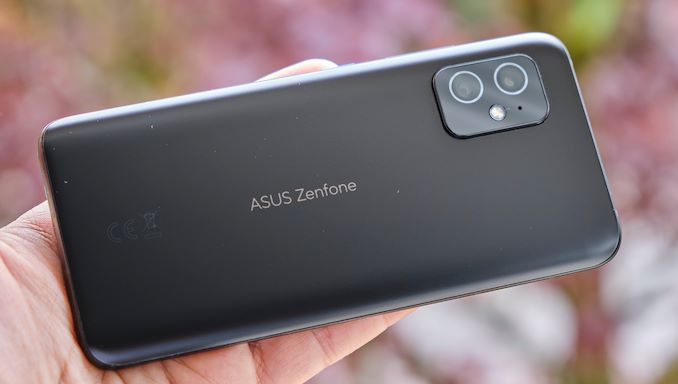
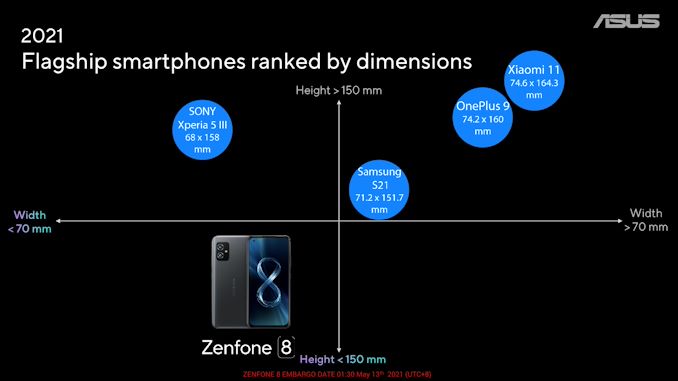
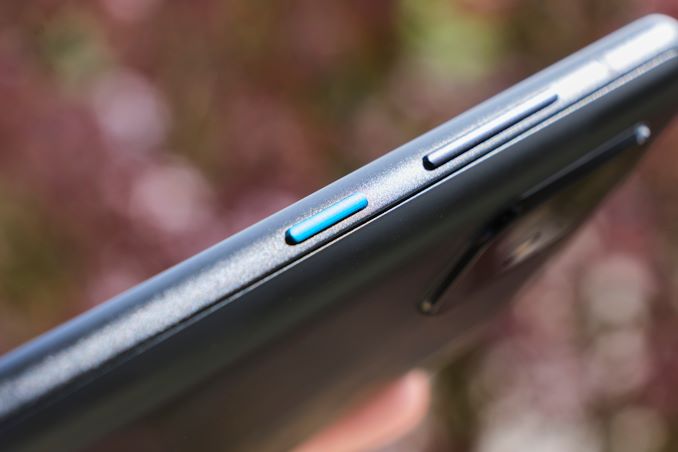
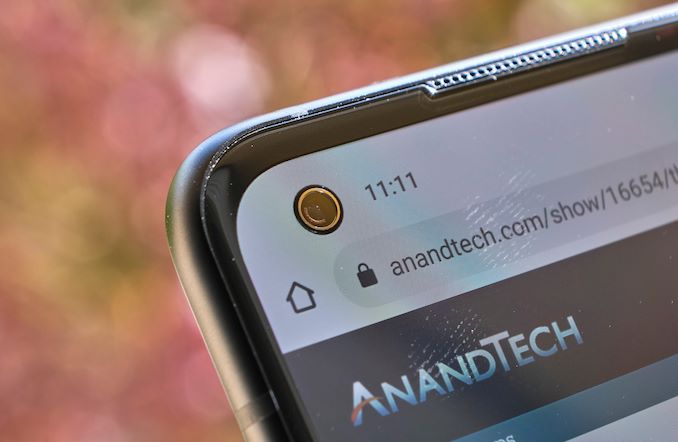


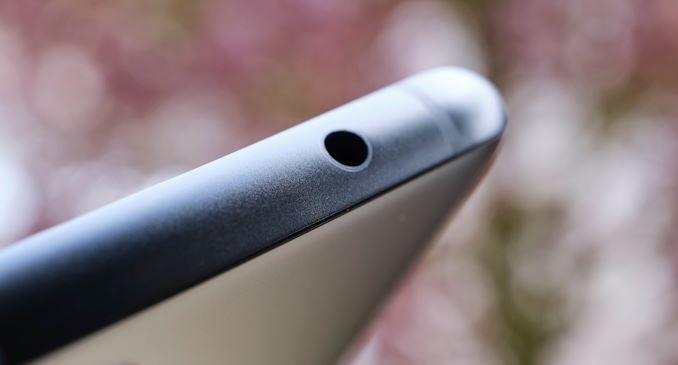








66 Comments
View All Comments
MrGutts - Thursday, May 13, 2021 - link
So let me get this right, the smaller version has a headphone jack but not the much larger unit?arashi - Sunday, May 16, 2021 - link
The larger unit is literally the old version with updated SoC. Laziest upgrade.Kangal - Tuesday, May 18, 2021 - link
The new QSD 888 isn't that much faster than the QSD 865, due to throttling. And the QSD 865 itself isn't that much faster than the QSD 855. Basically having QSD 855 in 2022 is still considered luxury/"flagship" level, unless you're in the iOS Market. With that said, the new "high-end" level chipset, QSD 780, is around the QSD 860 level. So that's a bargain. Maybe that's what ASUS should've gone for instead.After a year (or two), we should see a better, newer and optimised AndroidOS version, that is running on the next platform ARMv9. So I expect a good performance leap up from the QSD 888+, similar (probably better) to the performance leap from the Early QSD 845 to the Later QSD 855+.
XMight - Thursday, May 13, 2021 - link
Looks cool phone, the kind I would use, but, has 2 drawbacks:1. no sd card slot. Its not the problem that 128 GB is not enough for me, its just having the possibility to store data outside internal memory and access it fast without plugging the phone in a PC.
2. No FM radio in Europe. I'm tired of this, honestly. I look forward when Europe will force by law, like US, phone manufacturers to include FM radio. I really enjoy FM radio and even if I have unlimited plan, FM radio sounds way cooler and it feels more real-time than internet radio with apps with lots of ads and bloatware. Radio on Nokia 5 sounds really cool. I waited for Sony 5 III, which could have been my next phone, but no radio. Sony 10 III has no gyro, and I look at the stars with the phone through stellarium.
And the whole issue is that there isn't a single phone on the market that has: SDCARD, FM RADIO, dualsim, GYRO, Snapdragon CPU, IP rating, 3.5mm, small form-factor at the same time. So, I will stick to my Nokia 5 and Sony XZ1 compact combination for a few more years. I really hate this marketing crap the companies are pulling for forcing people buy something they aren't 100% satisfied with at the moment so they will feel incentivized when a new phone with something they wanted appears, but misses something else they had before.
msildoja - Monday, July 5, 2021 - link
Totally agree with the second part. No good compact phone on the market. Purchased xperia 5ii but returned it as it was too long. Went for asus zf8, but it has so poor battery life compared to xpetia 5ii. Sad. Reall no good phones available after sony ditched the compact series.yetanotherhuman - Friday, July 9, 2021 - link
Yeah, it's incredibly tiring. I recently got a new phone, but it was too big. I left it in the box and carried on using my 4 year old phone instead.patel21 - Thursday, May 13, 2021 - link
Hi Andrei,Wouldn't a 870 or even 865 make more sense in a compact phone like this which isn't able to use 888 to its fullest?
They could even shave off a bit from price and the battery would also last longer
sheh - Thursday, May 13, 2021 - link
Roughly the same size as the S10 and S20.A good start, but shaving extra 2-3mm width and 10mm height would be welcome.
tkSteveFOX - Friday, May 14, 2021 - link
Strange, other reviews praise the camera for the price, but I also looked at their photos and more willing to go with your assumption.Ultrawide especially was lacking in fine detail even in broad daylight, and there's too much sharpening going in postprocessing. The main camera looks decent, but got to be expecting better than IMX686, however the front camera is miles better than anything in that price range.
SolarBear28 - Friday, May 14, 2021 - link
This is pretty much the size and price I'd want for my next phone. My 2018 Galaxy A8 is a fantastic device and still getting quarterly security updates. I'd like to stick with Samsung for their Good Lock and One Hand Operation apps but they don't makes any good phones under 6" anymore. The S21 is a fantastic device but slightly bigger and slightly more expensive than I'd like.